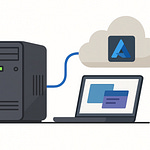Introduction: Why Your OneDrive Is Slow
You’re not unlucky. Your OneDrive isn’t haunted. It’s slow because you’re still treating cloud storage like an external hard drive from 2007. The spinning sync icon, the phantom “Processing changes…”, the fan ramping like it’s about to take flight—those are symptoms, not mysteries. The truth? You’re forcing your device to mirror entire SharePoint libraries you barely touch. That’s storage bloat, CPU churn, and network thrash—all for files you don’t need locally.
Here’s the fix: stop syncing everything. Use shortcuts. They give you instant access without dragging terabytes into your laptop’s tiny, overworked SSD. Today I’ll show you exactly why the old method fails and how shortcuts save storage, boost performance, and keep governance intact.
The Hidden Cost of Traditional Syncing (The 2007 Method)
Let’s define the 2007 method: you click Sync on a SharePoint library and pull the whole thing into File Explorer. It feels comforting—local-looking folders, everything “right there.” The problem? You just invited a marching band of files, folders, and metadata to live rent-free in your machine’s head. And yes, the parade never stops.
First cost: metadata overhead. Every item comes with properties—names, sizes, modified dates, authors, versioning pointers. Sync doesn’t just grab the content; it negotiates the structure, indexes it, and keeps it coherent. Thousands of items? That’s thousands of conversations with your disk and CPU. It’s like asking your laptop to memorize a phone book just in case you call one contact.
Second cost: file system integration. The OneDrive client hooks into the OS to present cloud files as local entries. That integration is powerful, but it’s not free. The more items you expose, the more the OS has to index, thumbnail, preview, and watch for changes. You scroll a giant folder, and Windows obligingly renders previews. That’s your CPU paying an “aesthetic tax” for content you’ll never open.
Third cost: bandwidth and churn. Even with Files On-Demand, syncing a large library means the client still evaluates each item, checks change states, and negotiates conflicts. Network traffic spikes not because you’re opening files, but because your client is reconciling the world’s most boring long-distance relationship—constantly checking, “Are we still in sync?” Multiply that by multiple devices, and congratulations, you’re running a distributed consensus algorithm to read a single deck.
Fourth cost: storage creep. “But Files On-Demand!” Yes, and yet users still pin folders “Always keep on this device” for travel or out of fear. That one checkbox quietly hoards gigabytes. Then version history and temporary caches nibble at the edges. Suddenly your 256 GB device is doing cosplay as a file server, and Windows Update is begging for space.
Fifth cost: reliability. Larger sync scopes magnify error surface. A single funky filename, a path too long, or a wonky permission in a nested folder can stall the queue. Now every change waits behind a traffic cone because one subfolder can’t make up its mind. You’ll see “Can’t sync this library” for reasons that vanish when you stop forcing the entire library to live locally.
Sixth cost: governance drift. Full sync encourages copies. Users drag files to Desktop, email them, duplicate them for “safety.” Now you’ve got five versions, four opinions, and one audit headache. You moved outside the governed source. Retention, sensitivity, access—all now a guessing game. The more you sync locally, the easier it is to fork content into unmanaged pockets.
Seventh cost: cross-device tax. Every new machine means re-adding those same giant libraries. Each device rebuilds indexes, re-evaluates file states, and re-learns the same lessons you refused to learn once. It’s Groundhog Day with more spinning wheels.
And here’s the kicker: you don’t even gain certainty. People sync “just in case,” but Files On-Demand already gives you the illusion of local with cloud-backed reliability. The difference is scope. Traditional sync says “bring the neighborhood.” Smart access says “bookmark the door.”
Now, why is this painfully familiar? Because it used to be the only way to make SharePoint usable in File Explorer. That was then. Today, “Add shortcut to OneDrive” gives you the same navigability without the bulk. Shortcuts surface precisely the folders you actually use, nested right inside your OneDrive. They roam across devices automatically. They don’t drag the entire library into the OS watcher. They don’t pressure your SSD. They don’t flood your network with pointless handshakes.
The thing most people miss: performance degrades exponentially with library size. Every additional thousand items adds not just one unit of work but branches of additional scanning, indexing, and state management. Shortcuts collapse the scope. Fewer items tracked. Fewer thumbnails rendered. Fewer permission edge cases. Fewer sync conflicts waiting to happen.
If you remember nothing else, remember this: traditional full-library sync optimizes for familiarity, not efficiency. It makes your laptop feel busy, not productive. And in an era of pooled storage and AI-driven discovery, treating cloud like a USB drive is quaint, wasteful, and, frankly, unprofessional. Use the cloud like the cloud. Limit your local blast radius. Point to the source. Use shortcuts.
Introducing OneDrive Shortcuts: The Modern Solution
Enter shortcuts—the adult way to access shared content without turning your laptop into a storage martyr. Add Shortcut to OneDrive doesn’t clone a library. It creates a lightweight pointer to exactly the folders you care about, and places them inside your OneDrive so they show up in File Explorer, Finder, and the OneDrive web—across every device you use. Essentially, you get doorways, not duplicates. Doorways don’t need cleaning, defragging, or babysitting.
Why this matters: scope. Shortcuts constrain the sync client’s awareness to what you actually work on. The OneDrive client still manages state, but across a sharply reduced set of items. That translates directly to fewer file system hooks, faster folder opens, quicker thumbnails, and a calmer activity center. The result is immediate: the “Processing changes…” spinner turns from a lifestyle into a blink.
And yes, offline still works—properly. Mark a shortcut folder or file “Always keep on this device” and only that subset is cached. Not the entire library. Not its six-year archive of retired brochures. Your SSD breathes. Your plane-time editing is focused. When you reconnect, the sync client reconciles a small, purposeful set of changes instead of litigating a corporate archive from 2014.
Cross-device behavior is another win. Shortcuts roam with your OneDrive identity. Sign in on a new machine and your shortcuts appear where you expect—no hunting through SharePoint URLs, no repeating the “Sync this library” ritual. It’s like muscle memory, but without the repetitive strain injury. Compare that to full-library sync, where you reconstruct the same sprawling mess on every fresh device. Efficiency equals consistency.
Governance fans—this is your moment. Shortcuts point to the single governed source. Sensitivity labels, retention policies, permissions, and version history all remain intact because you’re not copying anything. You’re not exporting content into unmanaged corners. You’re collaborating on the original. The reason this works is simple: governance applies to the file, not the doorway. So you keep compliance while regaining sanity.
Organization improves too. Shortcuts let you curate your working set. Pin the three client folders you actually use, ignore the rest of the library. You can even rename the shortcut locally for clarity—“Q4 Decks” instead of “Marketing-Field-Enablement-Assets-EMEA”—without touching the source. This is the interface equivalent of subtitles: the underlying content stays in its native language, you see what helps you think.
Now here’s where most people mess up: they assume shortcuts are merely a UI trick. They’re not. Under the hood, shortcuts reduce the sync graph—fewer nodes, fewer watchers, fewer permission edges to evaluate. That shaves CPU wake-ups, kills pointless network checks, and slashes the probability of a single bad filename freezing your queue. It’s not glamorous, but performance comes from subtracting the right complexity.
And because Microsoft finally acknowledged reality, the product now favors shortcuts. The Add Shortcut button is prominent in SharePoint libraries. Try to sync a folder you’ve shortcut already, and OneDrive can replace the old relationship. In File Explorer, those shortcut folders sit alongside your own, with clear naming that shows the real location. Translation: less “Where does this actually live?” and fewer panicked Teams messages at 4 p.m.
The game-changer nobody talks about is mental load. With full sync, your file tree becomes a museum. With shortcuts, it becomes a workstation—curated, current, and relevant. You open File Explorer and see the five places that matter. Decision fatigue drops. Navigation becomes muscle memory. And when your priorities change, you remove a shortcut. No cleanup. No tombstones. No “Are you sure?” prompts about deleting half a department.
If you remember nothing else: shortcuts are cloud-native literacy. They deliver access without baggage, offline without hoarding, and governance without gymnastics. They make your machine fast again by making your scope honest. You don’t need every file. You need the right doors. Add the doors. Stop moving the building.
Step-by-Step Guide: Adding Shared Libraries as Shortcuts
Let me show you exactly how to add only what you need—no storage bloat, no drama. We’re going from “giant library, endless syncing” to “surgical access” in a few clicks.
Start in SharePoint where the content actually lives. Open the site, go to the Documents library, and navigate to the specific folder you actually work in. Not the top-level “dump everything since 2013” folder—the one you touch weekly. In the command bar, click Add shortcut to OneDrive. If you don’t see it, you’re probably staring at the root library; drill into a subfolder or confirm you have permission to that path. Click it. Done. You’ve created a doorway, not a duplicate.
Now switch to OneDrive on the web. In the left nav, select My files. You’ll see a new entry with a chain link icon. That’s your shortcut. Rename it locally to something sane. Click the three dots, Rename, give it a name that matches how your brain files work—“Client A – Contracts,” not “Legal-Shared-Docs-v2.” You’re renaming the doorway, not the source. No governance harmed.
Let’s make it practical in File Explorer. Open File Explorer, go to your OneDrive. Your shortcut folder appears alongside your own folders. If you want it pinned for instant access, right-click and Pin to Quick Access. That’s your fast lane. For offline travel, right-click the specific subfolder or files inside that shortcut and choose Always keep on this device. Do not apply that to the shortcut root unless you enjoy recreating the exact mistake we’re escaping. Cache only what you’ll actually edit on a plane.
Replacing an old full sync with a shortcut? Good. First, identify the synced path: in File Explorer, look for the library name under your organization. Right-click the library and choose Settings, then click Stop sync. Confirm. If you already added a shortcut for that same folder, the OneDrive client is smart enough these days to replace the relationship cleanly. If it prompts about items that are open or pending upload, resolve those first. Translation: close the file you “left open since Tuesday.”
Back to SharePoint for multi-folder curation. You can add multiple shortcuts from different sites and libraries. Repeat: open the site, navigate to the working folder, Add shortcut to OneDrive. In OneDrive, group your shortcuts by creating a local “Work Hubs” folder and dragging your shortcut entries into it. You’re organizing your doors, not moving the building. If you ever need to remove one, right-click the shortcut in OneDrive and select Remove shortcut. The source remains untouched. The door vanishes. Bliss.
Need to share the source with teammates? Use the real share controls in SharePoint or OneDrive on the web from inside the shortcut. You’ll see modern sharing, including the upcoming hero link model—one superpowered link governing access. Copy the address bar URL when enabled; it’s the same link. You’re not emailing local paths. You’re not spawning orphans on people’s desktops. You’re granting access to the governed file.
Common mistakes to avoid. One: adding shortcuts to the root of every library like you’re collecting stamps. Curate. Two: marking entire shortcut trees Always keep on this device. Cache precisely. Three: dragging files out of a shortcut to your Desktop because “it’s faster.” That’s how you fork versions and break governance. Work in place. Four: re-syncing the full library later out of habit. If you feel the itch, take a walk, then add the single folder you actually need.
Admin tip: to migrate users at scale, communicate the pattern first—doorways, not duplicates. Then, schedule a fifteen-minute cleanup: stop legacy syncs, add three essential shortcuts, pin them, set offline for one subfolder. After rollout, check the OneDrive Sync Health dashboard for errors and stale builds. You’ll see fewer items, fewer failures, and fewer “Processing changes…” confessions. Congratulations. You’ve traded hoarding for intent.
Managing Your Shortcuts: Organization and Removal
Shortcuts are only powerful if you keep them tidy. Think of them like labeled doors on a hallway. Too many doors, no labels, and you’re back to wandering a maze. So let’s impose order.
Start with a naming convention. You need three parts: Who, What, When. For example: “Client-A – Contracts – Active” or “Finance – Q4 Reporting – 2025.” Front-load the category so similar shortcuts cluster alphabetically. Put the team or function first, then the specific purpose, then a time frame if it matters. It’s not art—it’s retrieval speed.
Create hubs. Inside OneDrive, make two or three top-level folders to corral your shortcuts: “Clients,” “Internal,” “Archive.” Drag shortcuts into those hubs. You’re not moving content, you’re arranging links. If your work spans multiple roles, add a “Now” folder and keep only the three most-used shortcuts there. Everything else lives one click away. The truth? Fewer visible choices equals faster decisions.
Use emoji sparingly as visual anchors. A briefcase for client work, a lock for regulated areas, a chart for analytics. One emoji, at the front, not a kindergarten art show. This helps your eye land on the right doorway instantly in File Explorer and on the web. And yes, it syncs fine.
Pin with intent. In File Explorer, right-click your top three shortcuts and Pin to Quick Access. Don’t pin fifteen; that defeats the point. On Mac, add them to the Finder sidebar. Refresh these pins monthly. If it hasn’t earned a pin in thirty days, it doesn’t deserve that prime real estate.
Surface working sets. Inside a shortcut, use Favorites (or Add to Quick Access) on the subfolders you touch daily. This gives you a two-level speed path: door, then desk. Mark just one or two subfolders Always keep on this device for travel. Cache expands; discipline contracts it.
Curate seasonal rot. End of quarter? Move shortcuts you no longer need into your “Archive” hub. Rename them with a suffix “(Archive)” so your brain knows they’re cold paths. Do not delete the shortcut just because a project ended; archived links are breadcrumbs for future audits.
Detect redundancy. If you have two shortcuts pointing into the same library at adjacent levels—say “Marketing – Campaigns” and “Marketing – Campaigns – Q4”—merge your intent. Keep the more precise one. The thing most people miss: overlapping scopes duplicate cognitive load and increase the chance you set the wrong folder to offline.
Audit monthly. Ten minutes. Open OneDrive web, sort by Type and filter for Shortcuts. Scan the list:
Not used in 30 days? Archive or remove.
Confusing names? Rename locally.
Duplicates? Consolidate.
Wrong owner team? Fix the name prefix.
Removal, the safe way. Removing a shortcut deletes the door, not the building. In OneDrive web or File Explorer, right-click the shortcut and choose Remove shortcut. If you get an error, you probably pinned subfolders for offline use. Clear Always keep on this device on any child items, wait for sync to settle, then remove. The source content remains governed and intact.
When you should delete the source? Rarely—and only in the actual SharePoint library with proper permissions and policy awareness. Use retention views, version history, and recycling workflows. Shortcuts are navigation, not authority.
Clean up legacy sync artifacts. If you previously synced a library and switched to shortcuts, you might still have a dusty local folder sitting under your organization name. Confirm it’s stopped syncing in OneDrive Settings. If it’s disconnected and empty, delete the local folder. If it still has content, you likely stranded files outside the source. Upload them to the correct SharePoint path, then retire the artifact. Don’t carry ghosts forward.
Governance alignment. If your org uses sensitivity labels or specific site naming standards, mirror those prefixes in your shortcut names: “[Confidential] Legal – M&A – Active.” That echo reduces misfiling and reminds you—subtle but effective—what not to download to every device.
Finally, embrace rotation. Your shortcut set should reflect your current quarter’s reality, not last year’s org chart. Add doors when priorities rise. Remove doors when they fade. A lean hallway is productive. A crowded hallway is chaos in slow motion. Keep it lean.
When to Sync vs. When to Use a Shortcut (The Decision Matrix)
Let’s end the guesswork. Here’s the decision matrix you should’ve had years ago.
Use a shortcut when the library is large, the team is broad, and you only touch a slice of it. Translation: most SharePoint libraries. Shortcuts constrain scope, cut CPU wake-ups, and keep you inside governance. If you open a few folders weekly and the rest is corporate archaeology, add shortcuts to the living parts and ignore the tombs.
Use a shortcut when you work across multiple sites. You need a curated working set from Sales, Legal, and Product? Don’t sync three libraries; add three surgical doors. They roam across devices automatically. New laptop, same clean hallway.
Use a shortcut when your device storage is finite—so, always. Shortcuts don’t hoard. Cache precisely what you’ll edit offline. Avoid turning a 256 GB ultrabook into a pretend file server.
Use a shortcut when stability matters. If sync errors and conflict dialogs ruin your afternoons, reduce the blast radius. Fewer tracked items means fewer chances for a single cursed filename to block the queue.
Use full sync only when offline is non-negotiable for the entire scope. Example: field teams in dead zones who genuinely need whole working folders—plural—at all times. Even then, define the smallest sensible boundary, not the entire site. You need reliable offline? Fine. You don’t need the last decade of PDFs.
Use full sync when you’re running local automations that must see files as native paths at scale—heavy scripting, third-party tools that don’t understand cloud placeholders, or workflows that expect an always-present tree. Even here, prune ruthlessly. Automations love narrow inputs.
Use full sync if you’re in a specialized scenario like media production where large binaries must be streamed locally for performance. But be honest: that’s a small population with beefy storage. If you’re on a thin-and-light, this is not you.
Avoid both when a link is enough. If you’re handing someone a one-off file, share it; don’t create a lifelong relationship to a folder you’ll forget tomorrow. Hero link models simplify this further. Share access; don’t architect access.
Rules of thumb, so you stop asking:
If you need visibility, not possession, use a shortcut.
If you need possession of a small, predictable subset, use a shortcut plus selective offline.
If you need blanket possession for critical offline work or rigid local tooling, use constrained sync.
If you think you need everything, you’re wrong. You need discipline.
Edge cases people bungle: departmental libraries with 50k items. Neither method is happy. Break the library into logical substructures, archive dead weight, and shortcut the active zones. Syncing that scale invites pain; shortcutting the root invites clutter. Structure first, then decide.
Another edge: legal holds and sensitivity labels. Shortcuts respect policy because they point at the governed source. Full sync doesn’t bypass policy, but it tempts behavior that does—dragging copies, emailing attachments. If retention and labeling matter, keep users in-place via shortcuts and modern sharing.
The truth? Most “sync or shortcut” debates are about comfort, not requirements. Comfort is expensive. Your CPU, your storage, your governance posture all pay for your nostalgia. Choose the smallest surface that satisfies the real constraint: access, offline, or automation. Then implement the least invasive path. That’s shortcuts nine times out of ten.
Conclusion: Future-Proofing Your Cloud Storage
Here’s the takeaway: treat the cloud like the cloud. Stop mirroring entire libraries because 2007 told you it felt safe. Shortcuts give you speed, governance, and sanity by shrinking your scope to the work that matters. Sync is a tool, not a lifestyle—use it only when offline scale or stubborn tooling actually demands it.
Now do the adult thing. Replace legacy syncs with three essential shortcuts. Pin them. Mark exactly one subfolder for offline. Kill the rest. If you want the migration playbook with naming conventions, offline rules, and an admin rollout checklist, subscribe and listen the next podcast. We’ll do the cleanup together and your laptop will finally act its age.










